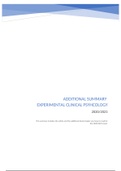ADDITIONAL SUMMARY
EXPERIMENTAL CLINICAL PSYHCOLOGY
2020/2021
This summary includes the article and the additional book chapter you have to read for
the 2020/2021 exam.
, 1
Includes
Singer, J. D. & Willet, J.B. (2003). Chapter 9: A framework for investigating
event
occurrence. In: Applied longitudinal data analysis: modeling change and
event
occurrence. Oxford University Press, 2003.
Vandenbroucke JP. (2008). Observational research, randomised trials, and two
views of
medical science. PLoS Med, 5(3):e67
, 2
Chapter 9: A framework for investigating event occurrence
Researchers who want to study event occurrence must learn how to think about their
data in new and unfamiliar ways. Even traditional methods for data description—the
use of means and standard deviations—fail to serve researchers well.
9.1 Should You Conduct a Survival Analysis? The “Whether” and “When” Test
Researchers use survival analysis in a variety of contexts that share a common
characteristic: interest centers on describing whether events occur or when events occur.
Data can be collected prospectively or retrospectively, over a short period of time or a
long one, in an experiment or an observational study. Time can be measured in years,
months, days, or seconds. The target event can occur once repeatedly over time. Event
occurrence can be beyond the individual’s control or well within his or her purview—for
example, having an abortion or stopping breast-feeding.
To determine whether a research question calls for survival analysis, we find it helpful to
apply a simple mnemonic we refer to as “the whether and when test.” If your research
questions include either word—whether or when—you probably need to use survival
methods.
9.2 Framing a Research Question about Event Occurrence
To determine whether a research question lends itself to survival analysis, you (p.310)
must also examine a study’s methodological features. Studies share three methodological
features that make them a candidate for survival analysis. Specifically, each has a clearly
defined:
1. Target event, whose occurrence is being studied.
2. Beginning of time, an initial starting point when no one under study has yet
experienced the target event.
3. Metric for clocking time, a meaningful scale in which event occurrence is recorded.
Event occurrence represents an individual’s transition from one “state” to another
“state” (e.g. a recently treated ex-alcoholic is abstinent (state 1) until he or she starts
drinking (state 2). The only requirement for survival analysis is that, in any particular
research setting, the states be both mutually exclusive (nonoverlapping) and exhaustive
(of all possible states). States must be defined precisely, with clear guidelines indicating
the behaviours, responses, or scores constituting each state. Empirical researchers often
find this the most difficult requirement to meet. In some situations, you can invoke
generally accepted definitions and criteria. Psychologists, for example, routinely use the
DSM classification system. Other times, you may use simple face valid definitions: a
woman is pregnant or not, an adult is employed or not. But there will be studies in which
state definition is difficult.
The “beginning of time” is a moment when everyone in the population occupies one,
and only one, of the possible states. On the day they are released from the hospital, all
recently treated alcoholics are abstinent; on the day they were hired, all new special
educators are teaching. Over time, as individuals move from the original state to the
next, they experience the target event. The timing of this transition—the distance from
the “beginning of time” until event occurrence—is referred to as the event time. In the
language of survival analysis, you want to start the clock when everyone in the
population is at risk of experiencing the event.




